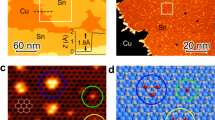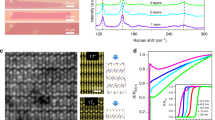Abstract
Disentangling the relationship between the insulating state with a charge gap and the magnetic order in an antiferromagnetic Mott insulator remains difficult due to inherent phase separation as the Mott state is perturbed1,2,3,4,5,6,7. Measuring magnetic and electronic properties at atomic length scales would provide crucial insight, but this is yet to be experimentally achieved. Here, we use spin-polarized scanning tunnelling microscopy (SP-STM) to visualize the periodic spin-resolved modulations originating from the antiferromagnetic order in a relativistic Mott insulator Sr2IrO4 (refs. 8,9), and how they change as a function of doping. We find that near the insulator-to-metal transition (IMT), the long-range antiferromagnetic order melts into a fragmented state with short-range correlations. Crucially, we discover that the short-range antiferromagnetic order is locally uncorrelated with the observed spectral gap magnitude. This suggests that static short-range antiferromagnetic correlations are unlikely to be the cause of the inhomogeneous closing of the spectral gap and the emergence of pseudogap regions near the IMT. Our work establishes SP-STM as a powerful tool for revealing atomic-scale magnetic information in complex oxides.
This is a preview of subscription content, access via your institution
Access options
Access Nature and 54 other Nature Portfolio journals
Get Nature+, our best-value online-access subscription
$29.99 / 30 days
cancel any time
Subscribe to this journal
Receive 12 print issues and online access
$209.00 per year
only $17.42 per issue
Buy this article
- Purchase on Springer Link
- Instant access to full article PDF
Prices may be subject to local taxes which are calculated during checkout




Similar content being viewed by others
Code availability
The computer code used for data analysis is available on request from the corresponding author.
References
Emery, V., Kivelson, S. & Lin, H. Phase separation in the t-J model. Phys. Rev. Lett. 64, 475–478 (1990).
Yee, C.-H. & Balents, L. Phase separation in doped Mott insulators. Phys. Rev. X 5, 021007 (2015).
Qazilbash, M. M. et al. Mott transition in VO2 revealed by infrared spectroscopy and nano-imaging. Science 318, 1750–1753 (2007).
Cai, P. et al. Visualizing the evolution from the Mott insulator to a charge-ordered insulator in lightly doped cuprates. Nat. Phys. 12, 1047–1051 (2016).
Battisti, I. et al. Universality of pseudogap and emergent order in lightly doped Mott insulators. Nat. Phys. 13, 21–25 (2017).
Chen, X. et al. Influence of electron doping on the ground state of (Sr1–xLax)2IrO4. Phys. Rev. B 92, 075125 (2015).
Yan, Y. J. et al. Electron-doped Sr2IrO4: an analogue of hole-doped cuprate superconductors demonstrated by scanning tunneling microscopy. Phys. Rev. X 5, 041018 (2015).
Kim, B. et al. Novel J eff = 1/2 Mott state induced by relativistic spin-orbit coupling in Sr2IrO4. Phys. Rev. Lett. 101, 076402 (2008).
Cao, G. & Schlottmann, P. The challenge of spin–orbit-tuned ground states in iridates: a key issues review. Rep. Prog. Phys. 81, 042502 (2018).
Mott, N. F. The basis of the electron theory of metals, with special reference to the transition metals. Proc. Phys. Soc. A 62, 416–422 (1949).
Imada, M., Fujimori, A. & Tokura, Y. Metal-insulator transitions. Rev. Mod. Phys. 70, 1039–1263 (1998).
Lee, P. A., Nagaosa, N. & Wen, X.-G. Doping a Mott insulator: physics of high-temperature superconductivity. Rev. Mod. Phys. 78, 17–85 (2006).
Rau, J. G., Lee, E. K.-H. & Kee, H.-Y. Spin-orbit physics giving rise to novel phases in correlated systems: iridates and related materials. Annu. Rev. Condens. Matter Phys. 7, 195–221 (2016).
Wiesendanger, R. Spin mapping at the nanoscale and atomic scale. Rev. Mod. Phys. 81, 1495–1550 (2009).
Jeon, S. et al. Distinguishing a Majorana zero mode using spin-resolved measurements. Science 358, 772–776 (2017).
Natterer, F. D. D. et al. Reading and writing single-atom magnets. Nature 543, 226–228 (2017).
Hirjibehedin, C. F. F., Lutz, C. P. P. & Heinrich, A. J. J. Spin coupling in engineered atomic structures. Science 312, 1021–1024 (2006).
Enayat, M. et al. Real-space imaging of the atomic-scale magnetic structure of Fe1+yTe. Science 345, 653–656 (2014).
Manna, S. et al. Interfacial superconductivity in a bi-collinear antiferromagnetically ordered FeTe monolayer on a topological insulator. Nat. Commun. 8, 14074 (2017).
de la Torre, A. et al. Collapse of the Mott gap and emergence of a nodal liquid in lightly doped Sr2IrO4. Phys. Rev. Lett. 115, 176402 (2015).
Cao, Y. et al. Hallmarks of the Mott-metal crossover in the hole-doped pseudospin-1/2 Mott insulator Sr2IrO4. Nat. Commun. 7, 11367 (2016).
Kim, Y. K., Sung, N. H., Denlinger, J. D. & Kim, B. J. Observation of a d-wave gap in electron-doped Sr2IrO4. Nat. Phys. 12, 37–41 (2016).
Kim, Y. K. et al. Fermi arcs in a doped pseudospin-1/2 Heisenberg antiferromagnet. Science 345, 187–190 (2014).
Chen, X. et al. Unidirectional spin density wave state in metallic (Sr1−xLax)2IrO4. Nat. Commun. 9, 103 (2018).
Wang, F. & Senthil, T. Twisted hubbard model for Sr2IrO4: magnetism and possible high temperature superconductivity. Phys. Rev. Lett. 106, 136402 (2011).
Ge, M. et al. Lattice-driven magnetoresistivity and metal-insulator transition in single-layered iridates. Phys. Rev. B 84, 100402 (2011).
Zhao, H. et al. Charge-stripe crystal phase in an insulating cuprate. Nat. Mater. 18, 103–107 (2019).
Guevara, J. M. et al. Spin-polaron ladder spectrum of the spin–orbit-induced Mott insulator Sr2IrO4 probed by scanning tunneling spectroscopy. Phys. Rev. B 99, 121114 (2019).
Kyung, B. et al. Pseudogap induced by short-range spin correlations in a doped Mott insulator. Phys. Rev. B 73, 165114 (2006).
Ye, F. et al. Magnetic and crystal structures of Sr2IrO4: a neutron diffraction study. Phys. Rev. B 87, 140406 (2013).
Kim, J. et al. Magnetic excitation spectra of Sr2IrO4 probed by resonant inelastic X-ray scattering: establishing links to cuprate superconductors. Phys. Rev. Lett. 108, 177003 (2012).
Zhou, S., Jiang, K., Chen, H. & Wang, Z. Correlation effects and hidden spin–orbit entangled electronic order in parent and electron-doped iridates Sr2IrO4. Phys. Rev. X 7, 041018 (2017).
Solovyev, I. V., Mazurenko, V. V. & Katanin, A. A. Validity and limitations of the superexchange model for the magnetic properties of Sr2IrO4 and Ba2IrO4 mediated by the strong spin-orbit coupling. Phys. Rev. B 92, 235109 (2015).
Zhao, L. et al. Evidence of an odd-parity hidden order in a spin–orbit coupled correlated iridate. Nat. Phys. 12, 32–36 (2016).
Lawler, M. J. et al. Intra-unit-cell electronic nematicity of the high-T c copper-oxide pseudogap states. Nature 466, 347–351 (2010).
Huang, D., Liu, S., Zeljkovic, I., Mitchell, J. F. & Hoffman, J. E. Etching of Cr tips for scanning tunneling microscopy of cleavable oxides. Rev. Sci. Instrum. 88, 023705 (2017).
Acknowledgements
We thank J. Hoffman, P. Lee and V. Madhavan for valuable discussions, and G. Gu for supplying the FeTe single crystals for characterizing spin-polarized STM tips. The spin-polarized STM measurements were supported by the US Department of Energy Early Career Award DE-SC0020130. I.Z. also acknowledges the support from the Army Research Office grant number W911NF-17-1-0399 (H.Z.) and the National Science Foundation grant number NSF-DMR-1654041 (A.U.) for developing the spin-polarized STM capability. Z.W. acknowledges the support from the US Department of Energy, Basic Energy Sciences grant no. DE-FG02-99ER45747. S.M. and J.M. would like to acknowledge the Office of Naval Research grant N00014-16-1-2657, the National Science Foundation grant DMR-1700137 and a grant from the John Templeton Foundation. S.D.W. acknowledges the support from the National Science Foundation award no. DMR-1905801 (S.D.W.), and additional funding support from the Army Research Office award W911NF-16-1-0361 (Z.P.).
Author information
Authors and Affiliations
Contributions
STM experiments were carried out by H.Z. H.Z., S.M. and A.U. were responsible for fabrication and initial characterization of spin-polarized STM tips. Iridate single crystals were grown by Z.P. and X.C., supervised by S.D.W. H.Z. analysed the STM data with guidance from I.Z. Z.W. provided theoretical input on the interpretation of the STM data. I.Z., S.D.W., Z.W., H.Z. and J.M. wrote the manuscript with input from all the authors. I.Z. supervised the project.
Corresponding author
Ethics declarations
Competing interests
The authors declare no competing interests.
Additional information
Peer review information Nature Physics thanks Milan Allan and the other, anonymous, reviewer(s) for their contribution to the peer review of this work.
Publisher’s note Springer Nature remains neutral with regard to jurisdictional claims in published maps and institutional affiliations.
Supplementary information
Supplementary Information
Supplementary Figs. 1–13 and refs. 1–16.
Source data
Source Data Fig. 1
Data plotted in Fig. 1f,g.
Source Data Fig. 2
Data plotted in Fig. 2g,h.
Source Data Fig. 4
Data plotted in Fig. 4e,f.
Rights and permissions
About this article
Cite this article
Zhao, H., Manna, S., Porter, Z. et al. Atomic-scale fragmentation and collapse of antiferromagnetic order in a doped Mott insulator. Nat. Phys. 15, 1267–1272 (2019). https://doi.org/10.1038/s41567-019-0671-9
Received:
Accepted:
Published:
Issue Date:
DOI: https://doi.org/10.1038/s41567-019-0671-9
This article is cited by
-
Hidden non-collinear spin-order induced topological surface states
Nature Communications (2024)
-
Electron Doping and Enhanced Conductivity in Vacuum Annealed Sr2-xLaxIrO4
Journal of Superconductivity and Novel Magnetism (2024)
-
Rotation symmetry breaking in the normal state of a kagome superconductor KV3Sb5
Nature Physics (2022)
-
Evidence for a spinon Kondo effect in cobalt atoms on single-layer 1T-TaSe2
Nature Physics (2022)
-
Spin-polarized imaging of the antiferromagnetic structure and field-tunable bound states in kagome magnet FeSn
Scientific Reports (2022)



